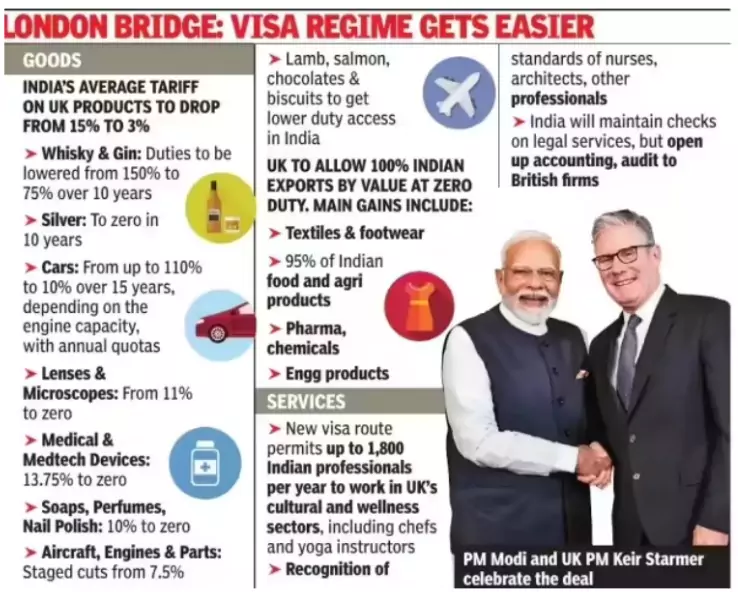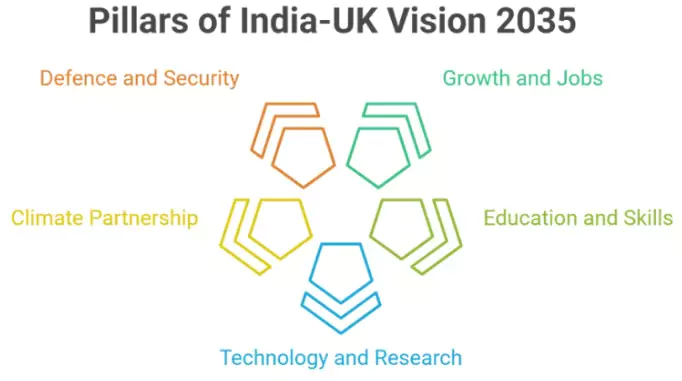
Recently, India and the United Kingdom have signed the Comprehensive Economic and Trade Agreement (CETA), marking a historic milestone in their bilateral trade relations.
- Key objective of the agreement: To double bilateral trade between the two countries by 2030.
About CETA (Comprehensive Economic and Trade Agreement)
- It is a type of FTA that covers a wide range of economic cooperation, including goods, services, investment, and non-tariff barriers.
India-UK bilateral trade and Investment
- India-UK bilateral trade (both goods and services) stood at around 43 billion during the 2024 with imports at around 17 billion and exports at around 26 billion pounds.
- Total bilateral trade in goods is around 18 billion pounds while trade in services is around 25 billion pounds in 2024.
- UK is the 6th largest inward investor in India, with a cumulative equity investment of US $ 35 billion till September 2024.
- India’s outward investment to UK is $19 billion till March 2024
|
Key Highlights of the India-UK Comprehensive Economic and Trade Agreement
- Tariff Elimination & Market Access: 99% tariff elimination covering 100% trade value for Indian exports.
- Sensitive sectors protected: Dairy, apples, oats, edible oils retain tariffs.
- Double Contribution Convention (DCC): 3-year exemption on UK social security contributions for Indian workers.
- Prevents double taxation, enhances take-home pay & cost competitiveness.
Sector-Wise Potential Benefits
- Agriculture & Marine
- Duty-free access for: Fruits, vegetables, spices, processed foods (95% agri-lines at 0% duty).
- Key beneficiary states: Maharashtra (grapes, onions), Gujarat (groundnut, cotton).
- Punjab/Haryana (basmati rice), Kerala (spices), NE states (horticulture).
- Marine sector: Shrimp, tuna, fishmeal gain 0% duty in the UK market.
- Andhra, Odisha, Kerala, Tamilnadu to expand fisheries exports (current share: 2.25%).
- Textiles, Engineering & Electronics
- Textiles: 1,100+ categories at 0% duty (vs. 12% earlier).
- RMG, home textiles, carpets to compete with Bangladesh/Pakistan.
- Target: 5% UK market share gain (current exports: $1.79B of UK’s $26.95B imports).
- Engineering: 0% duty (from 18%) to double exports to $7.5B by 2029-30.
- Electronics/Software: Smartphones, optical fibers, inverters gain 0% duty.
- IT/ITES: UK’s first ambitious services commitment (finance, telecom, education).
- Pharma & Chemicals
- Pharma: 0% duty for generic drugs.
- Medical devices (surgical tools, ECG machines) also duty-free.
- Chemicals: Expected 30-40% export growth .
- Other Sectors
- Plastics & Sports Goods: Films, pipes, packaging at 0% duty; target $187M by 2030.
- Toys/sports gear (cricket, soccer balls) to compete with China/Vietnam.
- Gems & Jewellery: Tariff cuts to double exports in 2-3 years.
- Leather: 0% duty (from 16%) to boost exports.
- MSME hubs (Agra, Kanpur, Chennai) benefit.
- Innovation & MSME Support: Promotes tech trade & R&D collaboration.
- MSMEs:
- GI protection (e.g., Kanpur leather, Agra footwear).
- Simplified standards & digital portals for export guidance.
Definitions of Key Trade Agreements
- FTA (Free Trade Agreement): A pact between two or more countries to reduce or eliminate trade barriers like tariffs and quotas on goods and services.
- Promotes trade by easing market access and fostering economic cooperation.
- CEPA (Comprehensive Economic Partnership Agreement): An advanced FTA that includes trade in goods, services, investment, and broader cooperation like technology and intellectual property.
- CECA (Comprehensive Economic Cooperation Agreement): A type of free trade agreement that goes beyond just reducing tariffs and includes provisions for cooperation in various sectors.
- BIT (Bilateral Investment Treaty): An agreement to promote and protect investments between two countries, ensuring fair treatment and dispute resolution.
- SPS (Sanitary and Phytosanitary Measures): Standards to protect human, animal, or plant health in trade, often involving certifications for food and agricultural products.
- Ensures safety but can act as non-tariff barriers (NTBs).
- NTB (Non-Tariff Barrier): Restrictions on trade other than tariffs, such as quotas, standards, or licensing requirements.
|
Key Drivers of CETA
- India’s Objectives: Gain duty-free access to the UK’s USD $46.3 billion agricultural market and USD 5.4 billion marine market.
- Enhance services exports, particularly in IT/ITeS (India’s services exports to UK: £14.7 billion in 2024).
- Facilitate professional mobility and exempt Indian workers from UK social security contributions via the Double Contribution Convention (DCC).
- Protect sensitive sectors like dairy, edible oils, and milled rice.
- UK’s Objectives:
- Access India’s growing market (1.4 billion population, rising middle class) for goods like whisky, automobiles, and salmon.
- Attract Indian investment in the UK’s financial and technology sectors (e.g., FinTech, green energy).
- Reduce tariffs on 90% of UK exports to India, covering 70% of trade value.
- Geopolitical Motivations
- UK’s Post-Brexit Strategy: Post-Brexit economic recovery and high inflation (2022–23) pushed the UK to seek stable trade partners like India.
- Post-Brexit, the UK sought to reduce reliance on the EU and China, prioritizing trade deals with fast-growing economies like India.
- The CETA aligns with the UK’s Global Britain vision, enhancing its influence in the Indo-Pacific and countering China’s economic dominance.
- India’s Global Trade Ambitions: India aims to boost exports to USD 2 trillion by 2030, with FTAs as a key driver.
- The CETA complements India’s FTAs with Australia, UAE, and ongoing talks with the EU, positioning India as a global trade hub.
- The CETA aligns with India’s Make in India, Atmanirbhar Bharat, and export promotion initiatives, boosting manufacturing and job creation.
- Indo-Pacific Alignment: Both nations share interests in a free and open Indo-Pacific, countering regional security challenges and fostering technology and defense cooperation.
Pre-CETA Trade and Investment
- Trade Volume: Bilateral trade grew from USD 50.1 billion in 2021–22 to USD 56 billion in 2024–25, driven by India’s exports in engineering, textiles, and gems.
- Investment: UK is India’s 6th largest FDI source, with USD 35 billion invested till Sep 2024. India invested USD 19 billion in the UK.
- There are 971 Indian companies operating in the UK employing over 1 lakh people. There are 667 British companies in India employing over 5 lakh people.
- MSME Contribution: Indian MSMEs contribute 30.1% to GDP (2022–23) and 45.8% to exports (2024–25), making them a key focus for CETA’s inclusivity measures.
India-UK Vision 2035
Prime Ministers of India and the United Kingdom, in July 2025 endorsed the new “India-UK Vision 2035 (replacing the Roadmap 2030)” that reaffirms their shared commitment to unlocking the full potential of a revitalised partnership.
- Strategic Partnership: It involves Comprehensive Strategic Partnership with a focus on mutual growth, prosperity, and shaping a sustainable future amidst global change.
- Economic Growth and Trade: It includes Comprehensive Economic and Trade Agreement (CETA), Bilateral Investment Treaty (BIT), Joint Economic and Trade Committee (JETCO) and India-UK Financial Partnership (IUKFP).
 Technology and Innovation: Its key focus includes on UK-India Technology Security Initiative, UK-India Research & Innovation Corridor and Critical Mineral Supply Chains Technology and Innovation: Its key focus includes on UK-India Technology Security Initiative, UK-India Research & Innovation Corridor and Critical Mineral Supply Chains- Climate and Clean Energy: It involves focus on Climate Partnership, Energy Collaboration and Deepened collaboration on the International Solar Alliance, Coalition for Disaster Resilient Infrastructure, One Sun One World One Grid (OSOWOG)
- Defence and Security: It focuses on Defence Industrial Roadmap, collaboration on Advanced Technologies and Indo-Pacific Oceans’ Initiative (IPOI)
- Education and Skills Development: It includes India-UK Education Dialogue, Green Skills Partnership and Youth Exchange Programs.
- People-to-People Ties: It includes Cultural and Educational Exchanges and Migration and Mobility Partnership.
- Commitment to Multilateralism: It focuses on Rules-based International Order and Reform of International Institutions.
|
Significance of the India-UK CETA
- Economic Milestone:
- Global Economic Positioning: As the world’s 6th (UK, GDP ~USD 3.9 trillion) and 4th (India, GDP ~USD 4.2 trillion) largest economies, the CETA strengthens bilateral economic ties, positioning both nations as key players in global trade.
- India’s FTA Strategy: Marks India’s 16th Free Trade Agreement (FTA) and its most comprehensive with a G-7 nation, aligning with India’s goal to boost exports to USD 2 trillion by 2030 (from USD 776 billion in 2024–25).
- Trade Expansion:
- Bilateral Trade Target: Aims to double bilateral trade by 2030, adding an estimated USD 34 billion annually to trade volumes.
- Market Access: India gains zero-duty access on 99% of tariff lines, covering nearly 100% of trade value for exports to the UK.
- UK secures tariff reductions on 90% of its tariff lines (70% of trade value) to India over 10 years.
- Strategic and Geopolitical Impacts
- Strategic Partnership:
- Indo-Pacific Alignment: Strengthens India-UK collaboration in the Indo-Pacific, supporting a free and open region amid geopolitical tensions (e.g., countering China’s influence).
- Technology and Defense: Complements existing cooperation under the India-UK Roadmap 2030, fostering innovation in FinTech, green energy, and defense manufacturing.
- Sources: The Hindu, The Week, Indian Express.
- Inclusivity and Sustainability:
- Promotes inclusive growth by empowering MSMEs, women entrepreneurs, farmers, fisherfolk, and youth, aligning with India’s Atmanirbhar Bharat and sustainable development goals.
- Encourages sustainable practices through provisions on traditional knowledge in patents and alignment with international standards (e.g., ISO, Codex).
- Indo-Pacific Stability:
- Strengthens India-UK alignment in the Indo-Pacific, countering China’s economic and strategic influence.
- Complements defense and technology cooperation under the India-UK Roadmap 2030.
- Global Trade Positioning:
- Bolsters India’s FTA strategy (e.g., with UAE, Australia, ongoing EU talks), enhancing its role as a global trade hub.
- Supports UK’s post-Brexit trade diversification, reducing reliance on EU markets.
- Innovation and Technology:
- Promotes collaboration in FinTech, green energy, and medical technology (e.g., duties on MedTech reduced from 15% to 3%).
- Encourages joint R&D and investment in sustainable technologies.
- Sustainability and Regulatory Impacts
-
- Sustainable Practices: Provisions protect traditional knowledge in patents (e.g., genetic resources) and align with international standards (ISO, Codex, IEC).
- Reduces non-tariff barriers via transparency (60-day advance notification of regulations) and mutual recognition of certifications (e.g., basmati rice, mangoes).
- Trade Facilitation: Streamlined customs through Single Window and Authorised Economic Operator systems.
- Bilateral SPS Committee to resolve technical issues, ensuring smoother agricultural exports.
Challenges of the India-UK CETA
- Economic Challenges
- Tariff Reduction Imbalance: UK offers 100% tariff line liberalization. India provides 90%, potentially limiting export gains.
- MSME Competitiveness: MSMEs (30.1% of GDP, 45.8% of exports) may struggle with UK standards. Compliance costs could limit benefits.
- Regulatory and Non-Tariff Barriers
- Non-Tariff Barriers (NTBs): UK’s strict SPS and TBT measures may hinder exports. Certifications remain costly for agriculture and marine products.
- India’s share in UK’s USD 63.4 billion agri-market (1.7%) and USD 5.4 billion marine market (2.25%) faces compliance hurdles.
- SPS Committee Effectiveness: Bilateral SPS Committee meets twice yearly. Delays in resolving standards disputes could impact perishable exports.
- Social and Employment Concerns
- Job Displacement Risk: Reduced tariffs on UK goods (e.g., whisky from 150% to 40%, cars from 100% to 10%) may hit Indian industries.
- Automotive and whisky sectors could lose jobs.
- Skill Gaps for MSMEs: Artisans and MSMEs lack skills for UK quality standards. This limits competitiveness in textiles and leather.
- Professional Mobility and DCC Challenges
- Visa Implementation: Simplified visas for Indian professionals (e.g., IT workers, yoga instructors) depend on UK immigration policies.
- Bureaucratic delays could restrict mobility.
- Double Contribution Convention (DCC): DCC exempts Indian workers from UK social security for 3 years. Disputes over eligibility or reciprocity may arise.
- Geopolitical and Strategic Concerns
- UK’s Economic Instability: UK’s post-Brexit challenges (e.g., inflation) may limit CETA commitments. FDI growth (USD 11.7 billion, 2000–2023) could slow.
- China’s Influence: CETA counters China’s economic dominance. Rising India-China tensions could complicate trade strategy.
- Implementation and Monitoring Challenges
- Execution Delays: Tariff cuts, visa simplifications, and SPS mechanisms need timely execution. Delays could reduce trade benefits.
- Dispute Resolution: Lack of clear dispute resolution mechanisms may lead to trade conflicts. Issues like standards or tariffs could escalate.
- Domestic Political and Public Perception
- Stakeholder Opposition: Dairy and automotive sectors may resist UK imports. Farmer protests could arise over perceived urban bias.
- Dairy (5% GDP), automotive (7% GDP) are sensitive sectors.
- Political Shifts: Changes in UK or Indian government priorities may affect CETA enforcement. Protectionism could rise.
India-UK Bilateral Relations Overview
- Strategic Partnership and Vision 2030
- Comprehensive Strategic Partnership: Announced during the India-UK Summit (2021) to steer cooperation over the next decade.
- India-UK Roadmap 2030: A framework to strengthen bilateral ties in trade, technology, defence, education, climate change, and security.
- Engagements
- PM Modi’s Visit to UK (COP26 Summit 2021): Launched ‘One Sun, One World, One Grid’ (OSOWOG) program for solar energy and IRIS for disaster-resilient infrastructure.
- Defence Cooperation
- Joint Military Exercises: Exercise Konkan 2023, Cobra Warrior 2023, and Ajeya Warrior 2023.
- Maritime Cooperation: Enhancing collaboration under the Indo-Pacific Oceans’ Initiative (IPOI).
- Science & Technology Collaboration
- India-UK Science and Innovation Council (SIC): Focus on quantum technology, clean energy, AI, and machine learning.
- Net Zero Innovation Virtual Centre: Platform for industrial decarbonization and green hydrogen initiatives.
- Health Sector Cooperation
- COVID-19 Vaccine Collaboration: AstraZeneca and Serum Institute of India jointly developed the COVID-19 vaccine.
- Health Workforce Agreement (2022): Focus on NHS recruitment and training, with Indian healthcare professionals playing a key role in the UK.
- Educational and People-to-People Exchanges
- Indian Students in UK: Over 170,000 Indian students studying in the UK.
- Mutual Recognition of Qualifications (2022): Enhances educational cooperation between both countries
- Migration and Mobility Partnership (2021): Facilitates easier movement for professionals
- Young Professional Scheme (2022): 3000 annual visas for graduates to work and live in each other’s country.
- UK universities in India: Six UK universities working to open campuses in India under the New Education Policy (NEP).
- Southampton University, opened its campus in Gurugram in 2025, is the first foreign university to open its campus in India under the NEP.
- Indian Diaspora in the UK
- Indian Diaspora (2021 Census): 1.864 million people of Indian origin, making up 2.6% of the UK population.
- Economic Contributions: The Indian diaspora has significant influence in business, 65,000 companies generating £36.84 billion in revenue, and creating 174,000 jobs.
|
Way Forward
- Protect Sensitive Sectors: Strengthen dairy (5% GDP, 80 million employed) and automotive (7% GDP) via PM Kisan and PLI schemes.
- Monitor UK lobbying through Joint Economic and Trade Committee (JETCO) to safeguard farmers.
- Balance Tariff Reductions: Accelerate tariff cuts for Indian exports like textiles (1,143 tariff lines) via Economic & Financial Dialogue (EFD).
- Negotiate Bilateral Investment Treaty (BIT) to ensure equitable trade benefits.
- Enhance MSME Competitiveness: Provide subsidies for UK certifications through MSME Ministry for SMEs (30.1% GDP, 45.8% exports).
- Launch training under India-UK Vision 2035 to meet UK standards.
- Address Non-Tariff Barriers: Fast-track mutual recognition of standards for agri (1.7% of USD 63.4 billion market) and marine exports (2.25% of USD 5.4 billion market).
- Strengthen SPS Committee with biannual meetings to resolve NTBs.
- Ensure Professional Mobility: Set up a visa taskforce to streamline processes for IT workers (USD 5 billion exports).
- Clarify Double Contribution Convention (DCC) eligibility via JETCO for 3-year exemptions.
- Navigate Geopolitical Risks: Balance ties with China via WTO and UN reforms.
- Strengthen Indo-Pacific security through Regional Maritime Security Centre of Excellence.
- Strengthen Implementation: Set clear timelines for tariff cuts and visas via Annual Ministerial Dialogue.
- Establish a CETA Dispute Resolution Panel for transparent conflict resolution.
Conclusion
The India-UK CETA and Vision 2035 mark a transformative partnership, boosting trade, technology, and strategic ties. Effective implementation, MSME support, and geopolitical balance are key to realizing mutual prosperity. CETA can also serve as a template for other Free Trade Agreements (FTAs), such as with the European Union, fostering deeper trade and economic partnerships.
Also Read: India and UK Free Trade Agreement; India-EU Free Trade Agreement; India UK CETA
![]() 25 Jul 2025
25 Jul 2025


